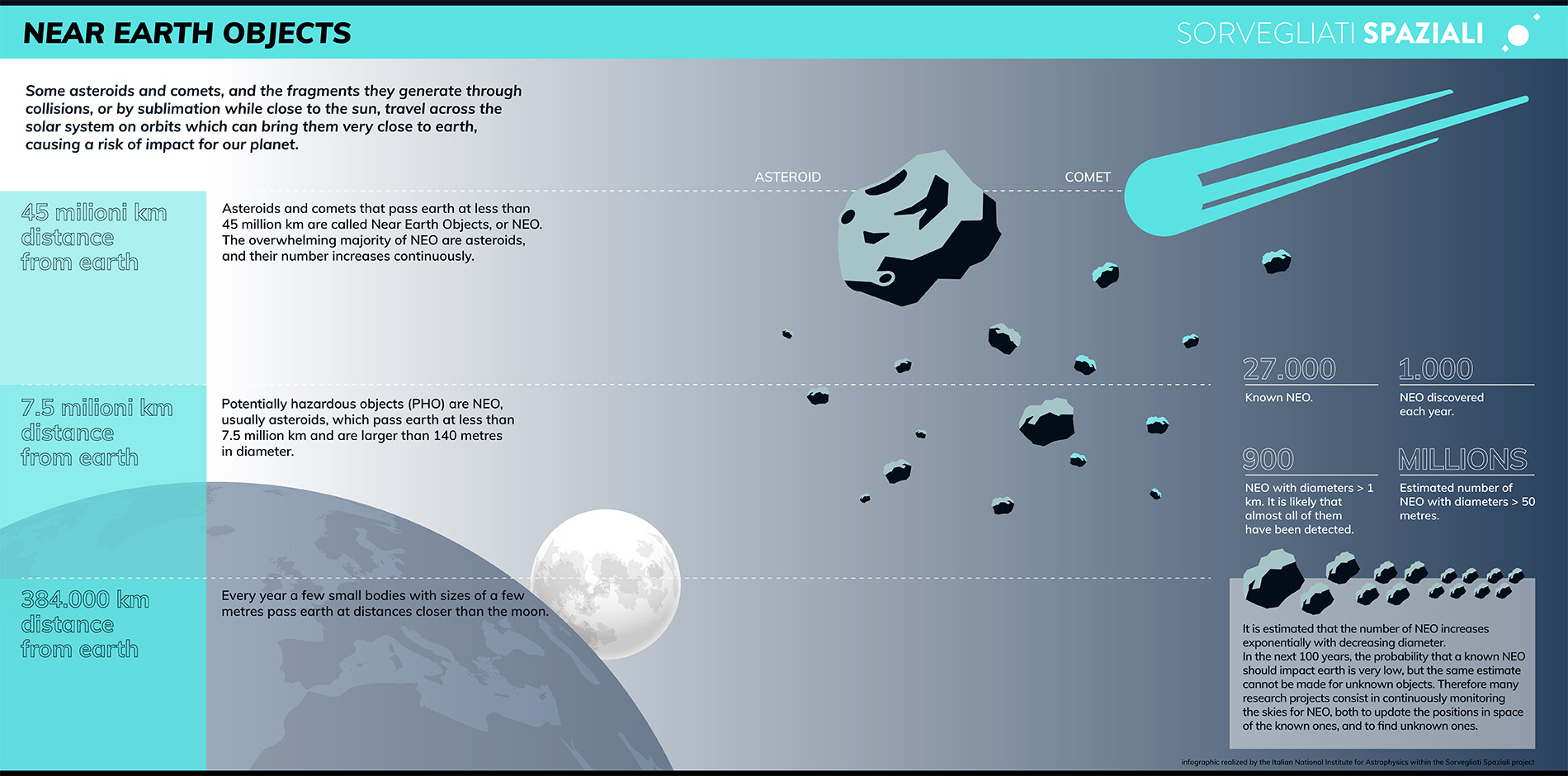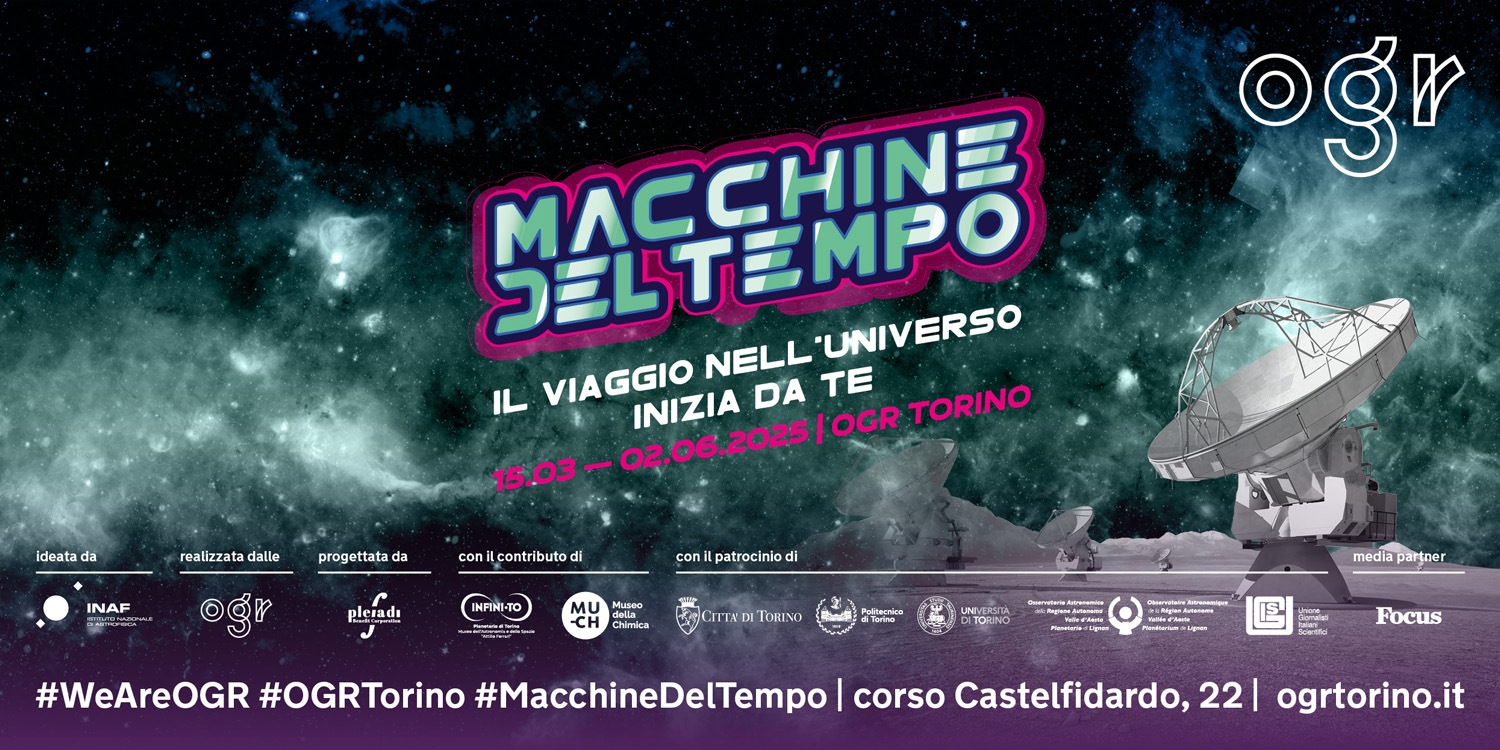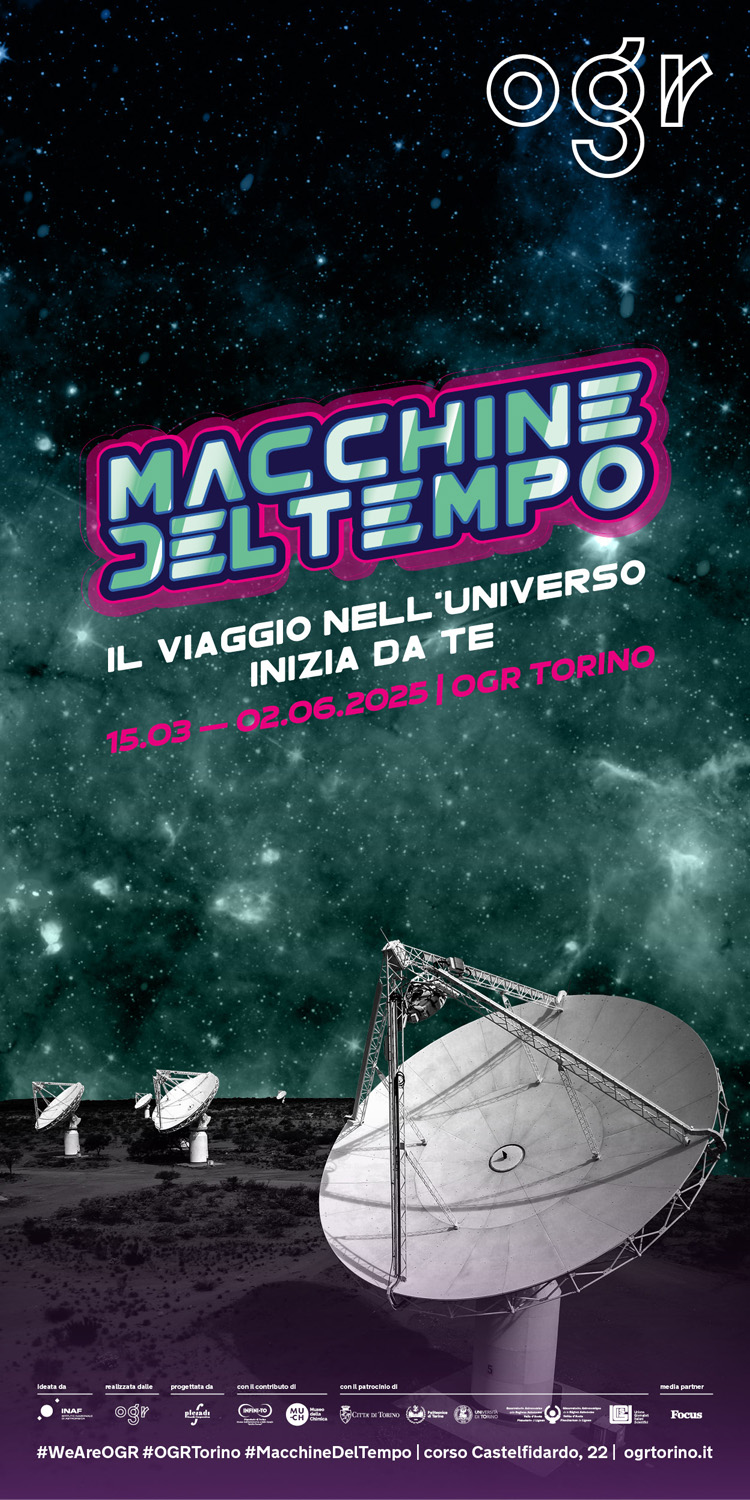Near
earth
objects
Asteroids and comets that approach the Earth’s orbit closer than 45 million km are classified as Near Earth Objects, or NEO.
The number of known NEO is steadily growing: at present there are about 26000, of which less than 10% are considered potentially dangerous, should they collide with Earth.
There are several ongoing programmes for the continuous monitoring of NEO. They aim to update the positions in space of known NEO, and to find previously unknown ones. Some NEO are of special scientific interest, because they could be explored with space missions, or used in asteroid deviation experiments.
Download the infographic by clicking here.
Face to face with NEO
If you wish to know more about NEO, or more specifically about NEA – asteroids whose orbits bring them close
Specifically
The name Near Earth Objects (NEO) identifies objects in orbit around the sun which could potentially collide with the earth. They are mostly asteroids, but also comets and their fragments (meteoroids) formed as the result of collisions, or through sublimation when a comet passes close to the sun. The number of known NEO increases continuously by about 1000/year, and is at present about 26000. NEO orbits are characteristically chaotic and almost unpredictable on time scales of decades, because of the gravitational perturbations caused by the much larger planets.
Asteroids and comets are globally catalogued as NEO when they pass earth at a distance closer than 45 million km. More specifically, they are labelled respectively as Near Earth Asteroids (NEA) or Near Earth Comets (NEC). About 26000 NEA and about 100 NEC are known at this time, so almost all NEO are asteroids.
If a NEO approaches earth at less than 7.5 million km, and its diameter is larger than 140 meters, it is classified as a Potentially Hazardous Object (PHO). About 26000 NEA and 2000 PHO are known at this time.
It is believed that some of the strongest impact events in earth’s history were caused by comets: as they approach from the farthest reaches of the solar system, they move faster than NEA, reaching speeds of 70 km/s. One can think of them as “falling” on earth from higher altitudes, therefore releasing more energy in the impact. So it is probably no coincidence that, in many popular traditions and legends, comets are considered as bad omens. It is possible that mankind experienced traumatic events caused by comets in a not too distant past.
At this time it is reckoned that 95% of NEO larger than 1km are known, numbering almost 900. There may be several millions of NEO larger than 50m. This diameter may not seem very threatening, but it was probably the size of the asteroid that caused the famous event in Tunguska, Siberia, on June 30, 1908, which led to the destruction of 2150 square km of Siberian taiga, and released about 800 times more energy than the nuclear bomb which destroyed Hiroshima.
June 30 was declared officially as International Asteroid Day by the United Nations in 2015, with the aim to increase public awareness about the importance of scientific research on these objects, and about the risk of impact from NEA.
In recent years many small NEA have passed close to earth, leading to some significant impact events. On October 7th, 2008, the asteroid 2008 TC3, a small rocky body with a diameter of about 5m, disintegrated upon entering the earth’s atmosphere above the Sudan, without causing any damage. This was the first collision by an asteroid which could be forecast about a day before the impact. The other significant event occurred on February 15th, 2013, in Chelyabinsk, Russia, when a small 20m asteroid entered the atmosphere and exploded at an altitude of about 30km. The resulting shock wave wounded about 1500 people, mainly by glass from broken windows.
The origin of NEO research can be set after World War II, when the Minor Planet Center (MPC) was established by the International Astronomical Union (IAU). MPC, which is funded by NASA’s Near-Earth Object Observation Program (NEOO), is still the main repository where observers from all over the world deposit all data on newly discovered NEO. A major technological advance took place in the 1990s through the Lincoln Near-Earth Asteroid Research (LINEAR) program of the Massachussets Institute of Technology (MIT), which made use of the new digital CCD detectors: they would soon revolutionize astronomical photography, by replacing the silver halide emulsion with the now well-known pixels.
Several worldwide programs are being carried out to continuously monitor NEO. Their two purposes are to continuously update the positions of known NEO, and to discover new ones. Besides the still active LINEAR, among the most important of these programs are the Catalina Sky Survey (CSS) and the PANoramic Survey Telescope And Rapid Response System (PAN-Starrs Neo). NASA is the main reference in the world for NEO survey projects, through the activity of the Center of NEO Studies (CNEOS); a brief history of their observational program can be found on its web site.
Italy has a very important role in NEO research: the town of Frascati, close to Rome, hosts the headquarters of the European Space Research Institute (ESRIN) where the Near-Earth Object Coordination Centre (NEOOC) operates. This is the NEO coordinating facility of the European Space Agency (ESA), specifically of its Planetary Defence Office (PDO). Many public and private Italian industries develop software and earth-bound detection systems (mainly radars), or propulsion systems and space technology: Thales Alenia Spazio Italia, Telespazio, Vitrociset, GM_Spazio,SpaceDys, Avio are just a few examples.
INAF’s role
Since its inception, in 1999, INAF has taken part in NEO research in the optical and radio bands. Many projects have been financed, or are being financed, in which INAF is leader or partner. Other partners include public institutions and private industries.
A notable example is CINEOS (Campo Imperatore Near Earth Objects Survey), active between 2001 and 2005 at INAF’s Campo Imperatore Observatory. Its purpose was the discovery and follow-up of NEO, in order to find new objects, and to improve the orbit characterization of the known ones. In 4 years of activity, it led to the discovery of 7 NEA, one comet, and more than 30000 new asteroids in the Main Belt. It also contributed to the re-discovery and/or improvement of orbit parameter accuracy for more than 20000 asteroids in the Minor Planet Center database.
Another remarkable project is NEOROCKS, led by INAF, in partnership with the Italian Space Agency (ASI) and with several academic and private collaborators. It was started in 2020 and will end in 2023, and aims to understand the physical and dynamical characteristics of NEO, through observations and modelling.
At the G.D. Cassini telescope in Loiano (BO), INAF performs optical astrometric observations to confirm and follow-up newly discovered NEO, collecting the data needed to determine their heliocentric orbits. Starting in July 2021, Cassini will be involved in the project Photometric and Astrometric Characterization of Deep-space Debris and Near-Earth Asteroids.
In the context of the CITO project, currently being carried out at Campo Imperatore Observatory, the CINEOS project could be reprised in the future, thanks to recent technical upgrades on both telescopes (including complete remote control of all systems). The purposes of CITO are the discovery and follow-up of NEO, and the physical and dynamical characterization of the brightest objects, at visible and near infrared wavelengths.
Radar observations of NEO which transit close to earth allow highly accurate measurements of their physical and dynamical properties, such as distance, velocity, rotation period, and surface metallicity. They also allow to obtain high-resolution images in 2D or 3D. These observations are made by bouncing radio signals off NEO and analyzing their reflection. Since the early 2000’s, INAF has taken part in several radar observing campaigns of NEO, using as receivers the dishes at the Radioastronomical Observatories in Medicina and Noto, and more recently the Sardinia Radio telescope.
At present INAF is collaborating with the ESA SSA-NEO center at ESRIN/Frascati and with the Minor Planet Center on planetary NEO tracking campaigns. INAF is also involved in the pilot project P3_NEO-XXII NEO Observation Concepts for Radar Systems, financed by ESA, to estimate the feasibility of NEO radar observations with European instruments.
Many INAF astronomers are involved in collaborations on observational projects. Particularly worthy of mention is theNature article in which Maurizio Pajola, from INAF Padova, contributed to calculate the age of asteroid Bennu, based on the craters identified on its surface by the Osiris-Rex probe.
For further informations take a look at Friends’ sites.


